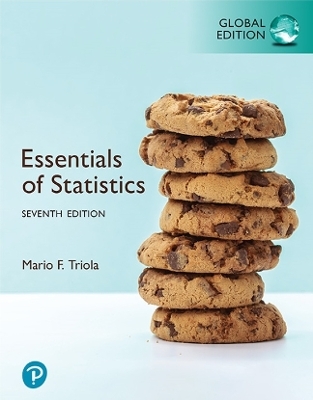
Stats: Data and Models, Global Edition -- MyLab Statistics with Pearson eText
Pearson Education Limited (Hersteller)
978-1-292-36226-7 (ISBN)
Preface
Index of Applications
I: EXPLORING AND UNDERSTANDING DATA
1. Stats Starts Here
1.1 What Is Statistics? 1.2 Data 1.3 Variables 1.4 Models
2. Displaying and Describing Data
2.1 Summarizing and Displaying a Categorical Variable 2.2 Displaying a Quantitative Variable 2.3 Shape 2.4 Center 2.5 Spread
3. Relationships Between Categorical Variables–Contingency Tables
3.1 Contingency Tables 3.2 Conditional Distributions 3.3 Displaying Contingency Tables 3.4 Three Categorical Variables
4. Understanding and Comparing Distributions
4.1 Displays for Comparing Groups 4.2 Outliers 4.3 Re-Expressing Data: A First Look
5. The Standard Deviation as a Ruler and the Normal Model
5.1 Using the Standard Deviation to Standardize Values 5.2 Shifting and Scaling 5.3 Normal Models 5.4 Working with Normal Percentiles 5.5 Normal Probability Plots
Review of Part I: Exploring and Understanding Data
II. EXPLORING RELATIONSHIPS BETWEEN VARIABLES
6. Scatterplots, Association, and Correlation
6.1 Scatterplots 6.2 Correlation 6.3 Warning: Correlation ≠ Causation *6.4 Straightening Scatterplots
7. Linear Regression
7.1 Least Squares: The Line of “Best Fit” 7.2 The Linear Model 7.3 Finding the Least Squares Line 7.4 Regression to the Mean 7.5 Examining the Residuals 7.6 R2–The Variation Accounted for by the Model 7.7 Regression Assumptions and Conditions
8. Regression Wisdom
8.1 Examining Residuals 8.2 Extrapolation: Reaching Beyond the Data 8.3 Outliers, Leverage, and Influence 8.4 Lurking Variables and Causation 8.5 Working with Summary Values *8.6 Straightening Scatterplots–The Three Goals *8.7 Finding a Good Re-Expression
9. Multiple Regression
9.1 What Is Multiple Regression? 9.2 Interpreting Multiple Regression Coefficients 9.3 The Multiple Regression Model–Assumptions and Conditions 9.4 Partial Regression Plots *9.5 Indicator Variables
Review of Part II: Exploring Relationships Between Variables
III. GATHERING DATA
10. Sample Surveys
10.1 The Three Big Ideas of Sampling 10.2 Populations and Parameters 10.3 Simple Random Samples 10.4 Other Sampling Designs 10.5 From the Population to the Sample: You Can't Always Get What You Want 10.6 The Valid Survey 10.7 Common Sampling Mistakes, or How to Sample Badly
11. Experiments and Observational Studies11.1 Observational Studies 11.2 Randomized, Comparative Experiments 11.3 The Four Principles of Experimental Design 11.4 Control Groups 11.5 Blocking 11.6 Confounding
Review of Part III: Gathering Data
IV. RANDOMNESS AND PROBABILITY
12. From Randomness to Probability
12.1 Random Phenomena 12.2 Modeling Probability 12.3 Formal Probability
13.Probability Rules!
13.1 The General Addition Rule 13.2 Conditional Probability and the General Multiplication Rule 13.3 Independence 13.4 Picturing Probability: Tables, Venn Diagrams, and Trees 13.5 Reversing the Conditioning and Bayes' Rule
14. Random Variables
14.1 Center: The Expected Value 14.2 Spread: The Standard Deviation 14.3 Shifting and Combining Random Variables 14.4 Continuous Random Variables
15. Probability Models
15.1 Bernoulli Trials 15.2 The Geometric Model 15.3 The Binomial Model 15.4 Approximating the Binomial with a Normal Model 15.5 The Continuity Correction 15.6 The Poisson Model 15.7 Other Continuous Random Variables: The Uniform and the Exponential
Review of Part IV: Randomness and Probability
V. INFERENCE FOR ONE PARAMETER
16. Sampling Distribution Models and Confidence Intervals for Proportions
16.1 The Sampling Distribution Model for a Proportion 16.2 When Does the Normal Model Work? Assumptions and Conditions 16.3 A Confidence Interval for a Proportion 16.4 Interpreting Confidence Intervals: What Does 95% Confidence Really Mean? 16.5 Margin of Error: Certainty vs. Precision *16.6 Choosing the Sample Size
17. Confidence Intervals for Means
17.1 The Central Limit Theorem 17.2 A Confidence Interval for the Mean 17.3 Interpreting Confidence Intervals *17.4 Picking Our Interval up by Our Bootstraps 17.5 Thoughts About Confidence Intervals
18. Testing Hypotheses
18.1 Hypotheses 18.2 P-Values 18.3 The Reasoning of Hypothesis Testing 18.4 A Hypothesis Test for the Mean 18.5 Intervals and Tests 18.6 P-Values and Decisions: What to Tell About a Hypothesis Test
19. More About Tests and Intervals
19.1 Interpreting P-Values 19.2 Alpha Levels and Critical Values 19.3 Practical vs. Statistical Significance 19.4 Errors
Review of Part V: Inference for One Parameter
VI. INFERENCE FOR RELATIONSHIPS
20. Comparing Groups
20.1 A Confidence Interval for the Difference Between Two Proportions 20.2 Assumptions and Conditions for Comparing Proportions 20.3 The Two-Sample z-Test: Testing for the Difference Between Proportions 20.4 A Confidence Interval for the Difference Between Two Means 20.5 The Two-Sample t-Test: Testing for the Difference Between Two Means *20.6 Randomization Tests and Confidence Intervals for Two Means *20.7 Pooling *20.8 The Standard Deviation of a Difference
21. Paired Samples and Blocks
21.1 Paired Data 21.2 The Paired t-Test 21.3 Confidence Intervals for Matched Pairs 21.4 Blocking
22. Comparing Counts
22.1 Goodness-of-Fit Tests 22.2 Chi-Square Test of Homogeneity 22.3 Examining the Residuals 22.4 Chi-Square Test of Independence
23. Inferences for Regression
23.1 The Regression Model 23.2 Assumptions and Conditions 23.3 Regression Inference and Intuition 23.4 The Regression Table 23.5 Multiple Regression Inference 23.6 Confidence and Prediction Intervals *23.7 Logistic Regression *23.8 More About Regression
Review of Part VI: Inference for Relationships
VII. INFERENCE WHEN VARIABLES ARE RELATED
24. Multiple Regression Wisdom
24.1 Multiple Regression Inference 24.2 Comparing Multiple Regression Model 24.3 Indicators 24.4 Diagnosing Regression Models: Looking at the Cases 24.5 Building Multiple Regression Models
25. Analysis of Variance
25.1 Testing Whether the Means of Several Groups Are Equal 25.2 The ANOVA Table 25.3 Assumptions and Conditions 25.4 Comparing Means 25.5 ANOVA on Observational Data
26. Multifactor Analysis of Variance
26.1 A Two Factor ANOVA Model 26.2 Assumptions and Conditions 26.3 Interactions
27. Statistics and Data Science
27.1 Introduction to Data Mining
Review of Part VII: Inference When Variables Are Related
Parts I—V Cumulative Review Exercises
Appendixes:
A. Answers
B. Credits
C. Indexes
D. Tables and Selected Formulas
| Erscheint lt. Verlag | 20.9.2021 |
|---|---|
| Verlagsort | Harlow |
| Sprache | englisch |
| Maße | 126 x 165 mm |
| Gewicht | 9 g |
| Themenwelt | Mathematik / Informatik ► Mathematik ► Statistik |
| ISBN-10 | 1-292-36226-X / 129236226X |
| ISBN-13 | 978-1-292-36226-7 / 9781292362267 |
| Zustand | Neuware |
| Haben Sie eine Frage zum Produkt? |
aus dem Bereich
